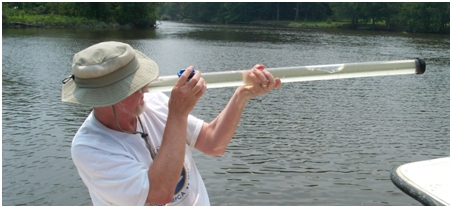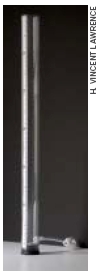The following has been reprinted from copyrighted material. The material should be referenced as:
Carlson, R.E. “Comparison study: horizontal and vertical transparency tubes.” Volunteer Monitor. 18: 20-21
Comparison Study: Horizontal and Vertical Transparency Tubes
by Robert E. Carlson
In a letter in the Summer 2004 issue of this newsletter (“Horizontal clarity methods from New Zealand”), Rob Davies-Colley of New Zealand’s National Institute of Water and Atmospheric Research (NIWA) described a horizontally held “clarity tube” used by volunteer monitors in New Zealand to measure water clarity in streams. The horizontal tube was inspired by another horizontal water clarity measurement used in New Zealand since 1989: the black disk method (Davies-Colley, 1988), in which a matte black target mounted on a stick is viewed horizontally underwater through an inverted periscope. The clarity tube makes ingenious use of a modified magnetic aquarium cleaner. An all-black target is attached to the inside magnet of the cleaner. The observer moves the target back and forth using the outside magnet, or slider.
Volunteer programs in the U.S. use vertically held tubes based on the turbidity tube (now usually called a transparency tube) originally developed in Australia (see The Volunteer Monitor Fall 1994 and Winter 2004). The tube has a target painted on the bottom – a pattern of wavy lines in the Australian model and a miniature black-and-white Secchi disk in most U.S. models. The observer looks down through the open top of the tube while lowering the water level until the target becomes visible. The original design required that water be poured out; later versions have an outlet tube at the bottom for releasing the water.
At the May 2004 National Water Quality Monitoring Council meeting in Chattanooga, Mike Scarsbrook of NIWA was kind enough to give me a New Zealand clarity tube. Although Kilroy and Biggs had reported (2002) that the horizontal clarity tube produces values similar to the horizontal black disk, I was not aware of any investigations comparing measurements made with the New Zealand tube to those made with the vertical transparency tube, and I was interested in performing such a study.
During the summers of 2004 and 2005, my students and I did side-by-side comparisons of the New Zealand tube and vertical transparency tube in tributaries and main bodies of Delaware and Chesapeake Bays in conjunction with a remote sensing survey conducted by the Cooperative Institute for Coastal and Estuarine Environmental Technology. The sites represented wide range of water clarity, dissolved color, and chlorophyll concentrations.
The transparency tube we used (donated by Water Monitoring Equipment and Supply) is 60 cm long with a miniature black and-white Secchi disk target attached to the bottom stopper (see photo, below left). The New Zealand clarity tube is 1 m long and has a matte black target attached to a magnetic slider, as described above.
Comparing the two tubes
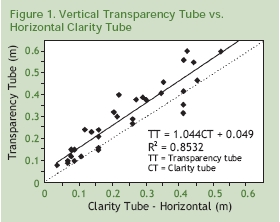 When we compared the two tubes using the same water sample, the vertical transparency tube produced significantly different (and higher) transparency readings than the New Zealand horizontal clarity tube (Figure 1).
When we compared the two tubes using the same water sample, the vertical transparency tube produced significantly different (and higher) transparency readings than the New Zealand horizontal clarity tube (Figure 1).
However, the slope for the relationship was not significantly different from 1, indicating that the two instruments are measuring the same aspects of water clarity. The difference in the readings may result from inherent differences in the manner in which light is attenuated in the horizontal and vertical orientations, as suggested by Davies-Colley, or it could result from the differences in the design and structure of the tubes or the targets.
Does orientation matter?
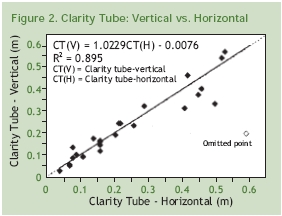 To test the first hypothesis, we took transparency readings with the New Zealand clarity tube held both vertically and in the recommended horizontal position. As shown in Figure 2, when one outlying point was omitted, the slope of the relationship was not significantly different from 1 and the intercept not significantly different from zero. In other words, the results were the same whether the tube was held horizontally or vertically.
To test the first hypothesis, we took transparency readings with the New Zealand clarity tube held both vertically and in the recommended horizontal position. As shown in Figure 2, when one outlying point was omitted, the slope of the relationship was not significantly different from 1 and the intercept not significantly different from zero. In other words, the results were the same whether the tube was held horizontally or vertically.
An explanation for the similarity of the readings may be that light enters at all points along the clear tube, whether vertical or horizontal, thus eliminating any orientation effect.
Using slider target in transparency tube
We then created a sort of hybrid tube by using the magnetic slider with the black target in the vertical transparency tube. Comparing the hybrid tube to the normal transparency tube, we found that the two instruments gave parallel results, but the values with the normal transparency tube were slightly higher (Figure 3). Apparently putting the black slider target into the transparency tube caused the transparency tube to behave like the clarity tube (see Figure 1). This suggests that the differences in readings seen in the first experiment mainly result from differences in the two targets, rather than other design differences between the tubes (such as tube length, diameter, or material).
Practical implications
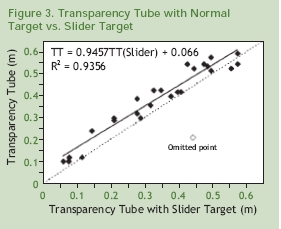 The reason the two targets give different readings requires further investigation, but our results imply that tube orientation is unimportant and that the clarity tube could be held vertically. A vertical tube with the magnetic slider target might be the best of all worlds, combining the advantages of a movable target with the advantages of a vertical orientation. We found the magnetic slider target to be a distinct improvement over the stationary target on the bottom of the transparency tube. It allows the user to repeat the reading several times without needing to refill the tube, and to watch the target both disappear and reappear (as is done when reading a Secchi disk). The slider is also much easier to manipulate than the various methods for draining water from vertical transparency tubes, and it avoids making a messy puddle on the ground or in the boat.
The reason the two targets give different readings requires further investigation, but our results imply that tube orientation is unimportant and that the clarity tube could be held vertically. A vertical tube with the magnetic slider target might be the best of all worlds, combining the advantages of a movable target with the advantages of a vertical orientation. We found the magnetic slider target to be a distinct improvement over the stationary target on the bottom of the transparency tube. It allows the user to repeat the reading several times without needing to refill the tube, and to watch the target both disappear and reappear (as is done when reading a Secchi disk). The slider is also much easier to manipulate than the various methods for draining water from vertical transparency tubes, and it avoids making a messy puddle on the ground or in the boat.
A vertical tube is more practical for a single operator because the horizontal clarity tube is hard to hold steady without a second person to support the distal end. Another advantage of a vertical tube is that it allows the user to look directly at the water surface, while a horizontal tube requires looking through a window (since the end of the tube must be closed). The viewing window makes the horizontal tube more expensive to produce, and the user needs to protect the window from scratches or other damage.
We are not suggesting that every program using transparency tubes switch to using a magnetic slider target, because the readings will be different. Switching might be considered if extensive crosscalibration shows a consistent relationship between the old and new targets in all types of water conditions. However, programs that are initiating transparency measurement should seriously consider using the slider.
References
Davies-Colley, R. 1988. Measuring water clarity with a black disk. Limnology and Oceanography 33:616-623.
Kilroy, C. and B.J.F. Biggs. 2002. Use of the SHMAK clarity tube for measuring water clarity: Comparison with the black disk method. New Zealand Journal of Marine and Freshwater Research 36:519-527.


